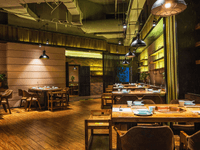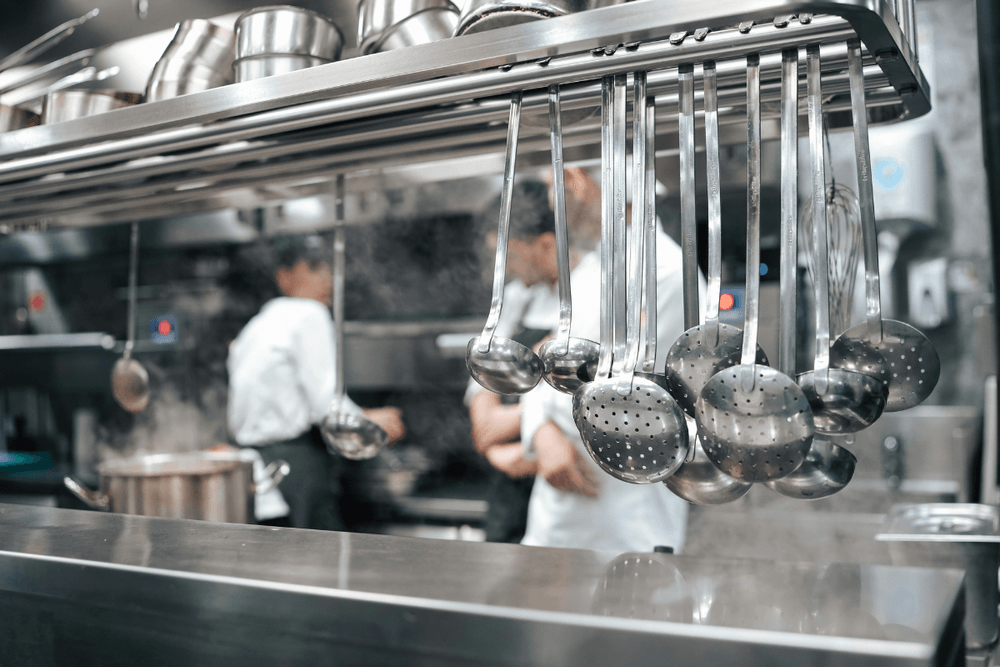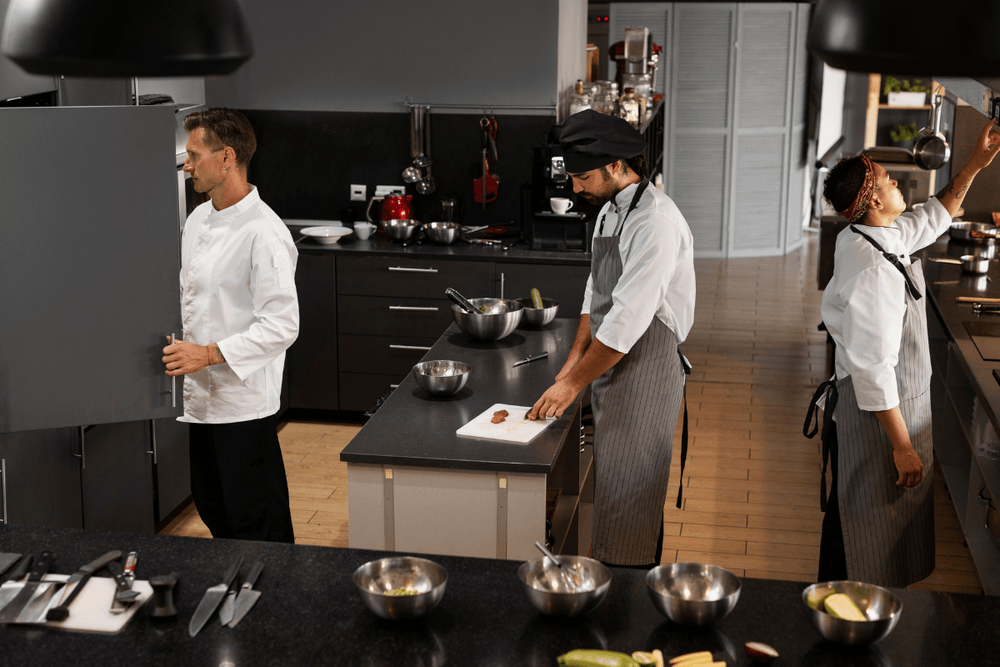Mastering the restaurant lease: Insider strategies for success and growth
Table of Contents
CloudKitchens
How many tacos can be delivered from a 1000sqft restaurant?
The same amount as a 200sqft ghost kitchen.
Leasing a restaurant space is one of the most significant commitments a food entrepreneur can make.
The restaurant lease not only dictates your financial obligations and operational flexibility, but it can also determine the very survival and growth trajectory of your business. Navigating these agreements is a complex process — a blend of art, negotiation, market knowledge, and legal savvy.
As traditional restaurant costs soar and consumer preferences evolve, choosing the right lease or innovative alternatives like CloudKitchens can spell the difference between resilience and risk.
Understanding the purpose of a restaurant lease
A restaurant lease is a legal contract between a property owner (landlord) and a restaurateur (tenant), granting the right to occupy and operate a food business in a specific location for a mutually agreed period.
The lease outlines rent, permitted uses, maintenance responsibilities, term length, renewal options, and more. Its primary purpose is to protect both parts: the restaurateur gains security and a designated workspace, while the landlord secures rental income and property upkeep.
Most restaurateurs favor triple net (NNN) leases or modified gross leases for predictability and control, but the “best” depends on your business model and ability to handle variable expenses. Percentage leases can help new concepts get a foot in the door with lower initial costs, sharing risk with landlords in exchange for a sales cut.
Functions of a restaurant lease:
- Provides legal clarity and structure for both parties;
- Defines the rights, obligations, and remedies for landlord and tenant;
- Lays out the terms for use, rent, duration, and permitted activities;
- Establishes a foundation for business planning and investment.
Read more: Commercial kitchens vs. traditional restaurants: which delivers the best ROI?
Types of leases for restaurants: What’s best for your business?
Choosing the right type of restaurant lease is vital, as it impacts everything from monthly costs to expansion potential.
1. Gross lease (full-service lease)
The tenant pays a single monthly amount that covers base rent and most or all property costs (such as taxes, insurance, and maintenance). While simple, the rent is typically higher to cover these items.
- Best for: Tenants who want predictability in monthly expenses.
2. Net lease (NNN, double, single)
In a net lease, tenants pay the base rent plus some (or all) property expenses:
- Single net lease (N): Base rent + property taxes
- Double net lease (NN): Base rent + property taxes + insurance
- Triple net lease (NNN): Base rent + property taxes + insurance + maintenance
Triple net leases are most common for stand-alone restaurants; costs can fluctuate, so budgeting is critical.
- Best for: Operators seeking lower base rent who can manage variable expenses.
3. Percentage lease
Rent is based on a fixed amount plus a percentage of gross sales above an agreed-upon threshold. This is common in malls or high-traffic retail centers.
- Best for: Locations where sales can be volatile or seasonal.
4. Modified gross lease
A hybrid model where the landlord and tenant share some costs. For example, the landlord may pay property taxes while the tenant pays utilities.
- Best for: Negotiating custom deals tailored to your business realities.
- Takeaway: The best type of lease for a restaurant depends on your comfort with risk, cash flow predictability, location, and growth plans.
Read more: Commercial Kitchen Codes for Your Restaurant
Evaluating a restaurant lease: Key factors
Before signing, consider the following critical elements to ensure a strong foundation:
1. Location, location, location
- Foot traffic and visibility: High-traffic areas can command higher rents but may offer greater sales potential.
- Accessibility: Proximity to transit, parking options, and delivery-friendly logistics can affect long-term success.
Read more: How central production kitchens benefit multi-location restaurants
2. Square footage and layout
- Efficiency vs. impression: Maximize operational workflow while considering seating capacity, kitchen needs, and code compliance.
- Expansion potential: Is there room for future growth or menu innovation?
3. Lease length and renewal terms
- Short-term (1–3 years): Offers flexibility, good for testing concepts.
- Long-term (5–10+ years): Secures location and rent but can limit pivot options.
Negotiate clear renewal options to ensure continuity as your business grows.
4. Rent structure and escalations
- Base rent: The set monthly cost for the space.
- Escalations: Built-in rent increases, usually tied to inflation, every 1–3 years.
- Do the math: Will future rent hikes outpace your expected revenue growth?
5. Additional/hidden costs
Understand all costs beyond rent, including:
- Common area maintenance (CAM) fees;
- Property taxes and insurance;
- Utilities (gas, water, electric, internet);
- Repairs, janitorial, pest control;
- Buildout and improvement costs (and who pays).
6. Tenant improvement (TI) allowance
- What it is: A sum paid by the landlord to subsidize renovations or buildout.
- Why it matters: Reduces startup costs, but may come with restrictions or payback clauses.
7. Use clause and restrictions
- Spell out exactly what kind of business and menu you can operate.
- Watch out for non-compete agreements, exclusive use clauses, and rules on alcohol service or live entertainment.
8. Rights and responsibilities
- Maintenance and repairs: Who fixes what, and how quickly?
- Subleasing and assignment: Can you transfer the lease or share space with a different operator if needed?
9. Exit clauses and early termination
- Breach of contract: Know the process and penalties for defaulting.
- Force majeure: Protects against rent obligations if disasters strike (fire, pandemic, etc.).
- Early termination options: What is the cost or process for breaking your lease if needed?
Read more: Restaurant location strategy: how to choose the most profitable spot
The lease negotiation process: Tips for success
Negotiating a restaurant lease requires a strategic and meticulous approach. It starts with thorough market research — comparing similar spaces, using local brokers, and referencing online listings, to understand market rates and typical terms. This groundwork ensures you enter negotiations with realistic expectations and a solid sense of value.
Working with specialized professionals, such as a commercial real estate agent or attorney, is invaluable. These experts can identify potential hazards in lease drafts, clarify ambiguous terms, and advocate for provisions that protect your interests and operation.
The negotiation process often begins with a letter of intent (LOI). This non-binding document outlines the essential business points, rent, duration, improvement allowances, and exclusivity, so both parties have a clear roadmap before drafting the final lease.
During negotiations, focus on securing tenant-friendly terms. This includes higher tenant improvement (TI) allowances, rent abatement for build-outs or seasonal challenges, expense caps for items like NNN or CAM charges, and exclusivity to avoid neighboring competitors.
Finally, always review every clause carefully — especially those covering renewals, escalations, and exit options. Ensuring fair arrangements for early termination or subleasing will provide flexibility and peace of mind throughout your restaurant’s leasing journey.
Read more: How much does it cost to start a restaurant business?
How CloudKitchens redefines the restaurant lease
Leasing a traditional restaurant often means locking into expensive, multi-year contracts, investing heavily in renovations, and facing substantial risk if consumer tastes or your business model changes.
As you’ve seen, navigating the complexities of a restaurant lease can be daunting and full of hidden obstacles. That’s why you can count on CloudKitchens as a modern, flexible alternative — enabling you to launch or expand your food business quickly, with lower up-front costs and far less risk. With CloudKitchens, you get the freedom to adapt, innovate, and grow your brand without the burdens and inflexibility of conventional restaurant leasing.
CloudKitchens advantages over traditional leases
- No buildout headaches: Move into a fully outfitted, health-code compliant commercial kitchen, ready for immediate use. No lengthy renovations or permit delays.
- Lower initial investment: Skip the six-figure buildout costs, start your restaurant or delivery brand with a fraction of traditional overhead.
- Flexible terms: Choose from month-to-month or short-term contracts, scaling up or down as your needs change.
- Prime locations: Access kitchens strategically located to maximize delivery range and customer hotspots, without a premium Main Street rent.
- Scalable innovation: Launch multiple brands from one kitchen, pivot menus fast, and test new concepts without signing a new lease every time.
- Compliance and support: Benefit from regulatory expertise, streamlined permitting, and operational assistance, covering the pain points of traditional leasing.
CloudKitchens empowers restaurateurs to thrive in a competitive landscape, without the burdens and rigidity of the traditional restaurant lease model.
Securing a restaurant lease is a high-stakes decision with long-lasting ramifications. From understanding lease types and terms to negotiating fair agreements and preparing for hidden costs, every detail counts. As the industry evolves, new models like CloudKitchens provide a path to resilience, efficiency, and rapid growth, without the financial and legal traps of a traditional lease.
If you’re ready to launch your next food venture, streamline your operations, or enter new markets with minimal risk, explore how CloudKitchens can be your competitive edge!
DISCLAIMER: This information is provided for general informational purposes only and the content does not constitute an endorsement. CloudKitchens does not warrant the accuracy or completeness of any information, text, images/graphics, links, or other content contained within the blog content. We recommend that you consult with financial, legal, and business professionals for advice specific to your situation.
More insights & stories
There’s more where that came from.
Get in the know and check out our additional insights




